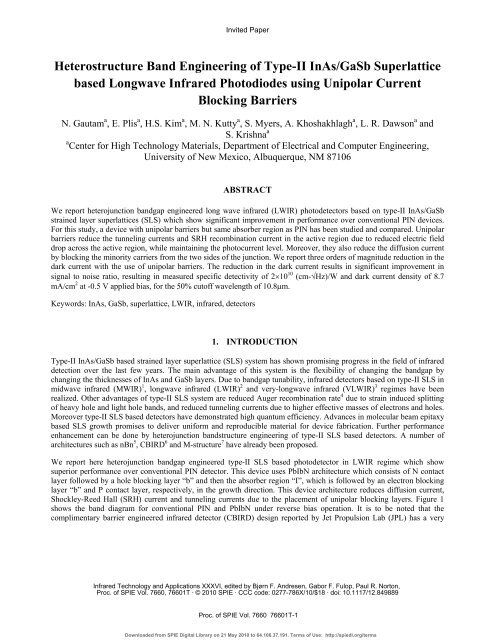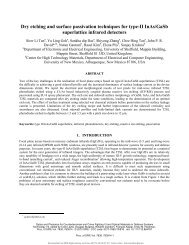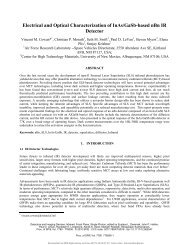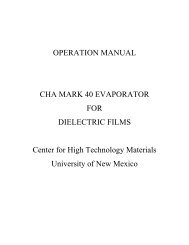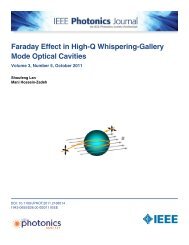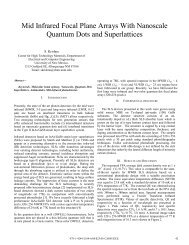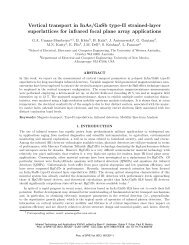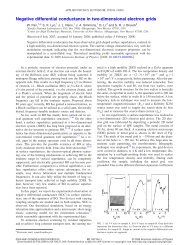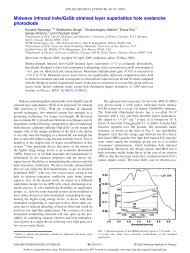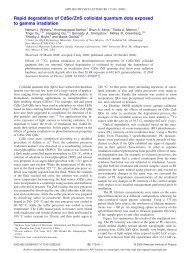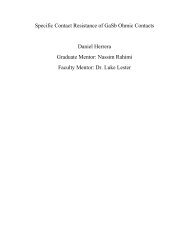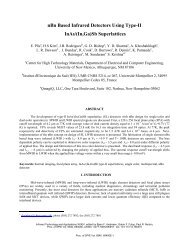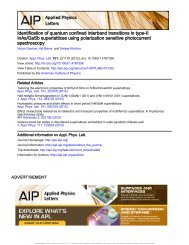Heterostructure Band Engineering of Type-II InAs/GaSb Superlattice ...
Heterostructure Band Engineering of Type-II InAs/GaSb Superlattice ...
Heterostructure Band Engineering of Type-II InAs/GaSb Superlattice ...
Create successful ePaper yourself
Turn your PDF publications into a flip-book with our unique Google optimized e-Paper software.
Invited Paper<br />
<strong>Heterostructure</strong> <strong>Band</strong> <strong>Engineering</strong> <strong>of</strong> <strong>Type</strong>-<strong>II</strong> <strong>InAs</strong>/<strong>GaSb</strong> <strong>Superlattice</strong><br />
based Longwave Infrared Photodiodes using Unipolar Current<br />
Blocking Barriers<br />
N. Gautam a , E. Plis a , H.S. Kim a , M. N. Kutty a , S. Myers, A. Khoshakhlagh a , L. R. Dawson a and<br />
S. Krishna a<br />
a Center for High Technology Materials, Department <strong>of</strong> Electrical and Computer <strong>Engineering</strong>,<br />
University <strong>of</strong> New Mexico, Albuquerque, NM 87106<br />
ABSTRACT<br />
We report heterojunction bandgap engineered long wave infrared (LWIR) photodetectors based on type-<strong>II</strong> <strong>InAs</strong>/<strong>GaSb</strong><br />
strained layer superlattices (SLS) which show significant improvement in performance over conventional PIN devices.<br />
For this study, a device with unipolar barriers but same absorber region as PIN has been studied and compared. Unipolar<br />
barriers reduce the tunneling currents and SRH recombination current in the active region due to reduced electric field<br />
drop across the active region, while maintaining the photocurrent level. Moreover, they also reduce the diffusion current<br />
by blocking the minority carriers from the two sides <strong>of</strong> the junction. We report three orders <strong>of</strong> magnitude reduction in the<br />
dark current with the use <strong>of</strong> unipolar barriers. The reduction in the dark current results in significant improvement in<br />
signal to noise ratio, resulting in measured specific detectivity <strong>of</strong> 2×10 10 (cm-√Hz)/W and dark current density <strong>of</strong> 8.7<br />
mA/cm 2 at -0.5 V applied bias, for the 50% cut<strong>of</strong>f wavelength <strong>of</strong> 10.8μm.<br />
Keywords: <strong>InAs</strong>, <strong>GaSb</strong>, superlattice, LWIR, infrared, detectors<br />
1. INTRODUCTION<br />
<strong>Type</strong>-<strong>II</strong> <strong>InAs</strong>/<strong>GaSb</strong> based strained layer superlattice (SLS) system has shown promising progress in the field <strong>of</strong> infrared<br />
detection over the last few years. The main advantage <strong>of</strong> this system is the flexibility <strong>of</strong> changing the bandgap by<br />
changing the thicknesses <strong>of</strong> <strong>InAs</strong> and <strong>GaSb</strong> layers. Due to bandgap tunability, infrared detectors based on type-<strong>II</strong> SLS in<br />
midwave infrared (MWIR) 1 , longwave infrared (LWIR) 2 and very-longwave infrared (VLWIR) 3 regimes have been<br />
realized. Other advantages <strong>of</strong> type-<strong>II</strong> SLS system are reduced Auger recombination rate 4 due to strain induced splitting<br />
<strong>of</strong> heavy hole and light hole bands, and reduced tunneling currents due to higher effective masses <strong>of</strong> electrons and holes.<br />
Moreover type-<strong>II</strong> SLS based detectors have demonstrated high quantum efficiency. Advances in molecular beam epitaxy<br />
based SLS growth promises to deliver uniform and reproducible material for device fabrication. Further performance<br />
enhancement can be done by heterojunction bandstructure engineering <strong>of</strong> type-<strong>II</strong> SLS based detectors. A number <strong>of</strong><br />
architectures such as nBn 5 , CBIRD 6 and M-structure 7 have already been proposed.<br />
We report here heterojunction bandgap engineered type-<strong>II</strong> SLS based photodetector in LWIR regime which show<br />
superior performance over conventional PIN detector. This device uses PbIbN architecture which consists <strong>of</strong> N contact<br />
layer followed by a hole blocking layer “b” and then the absorber region “I”, which is followed by an electron blocking<br />
layer “b” and P contact layer, respectively, in the growth direction. This device architecture reduces diffusion current,<br />
Shockley-Reed Hall (SRH) current and tunneling currents due to the placement <strong>of</strong> unipolar blocking layers. Figure 1<br />
shows the band diagram for conventional PIN and PbIbN under reverse bias operation. It is to be noted that the<br />
complimentary barrier engineered infrared detector (CBIRD) design reported by Jet Propulsion Lab (JPL) has a very<br />
Infrared Technology and Applications XXXVI, edited by Bjørn F. Andresen, Gabor F. Fulop, Paul R. Norton,<br />
Proc. <strong>of</strong> SPIE Vol. 7660, 76601T · © 2010 SPIE · CCC code: 0277-786X/10/$18 · doi: 10.1117/12.849889<br />
Proc. <strong>of</strong> SPIE Vol. 7660 76601T-1<br />
Downloaded from SPIE Digital Library on 21 May 2010 to 64.106.37.191. Terms <strong>of</strong> Use: http://spiedl.org/terms
similar heterostructure design 6 , with n-type top and bottom contacts and bottom contact made <strong>of</strong> bulk material unlike the<br />
PbIbN structure reported here.<br />
(a)<br />
(b)<br />
Figure 1. (a) Schematics <strong>of</strong> PIN photodetector under reverse bias (b) schematics <strong>of</strong> PbIbN detector under reverse<br />
bias operation which shows negligible field drop across active region.<br />
2. MATERIAL GROWTH AND CHARACTERIZATION<br />
Material was grown on Te doped epi-ready (100) <strong>GaSb</strong> substrate using a VG80 solid source molecular beam epitaxy<br />
system. The system was equipped with SUMO® cells for gallium and indium, a standard effusion cell for aluminum and<br />
cracker cells for antimony and arsenic. Growth rates were calibrated by monitoring the intensity oscillations in the<br />
reflected high-energy electron diffraction (RHEED) patterns and confirmed with X-Ray diffraction (XRD) by growth <strong>of</strong><br />
calibration superlattice (SL) samples with different thicknesses <strong>of</strong> SL periods. The reported PbIbN design has 637 nm<br />
thick N contact layer made <strong>of</strong> 16ML <strong>InAs</strong>/ 7ML <strong>GaSb</strong> doped with Te (n=3×10 18 cm -3 ) followed by non-intentionally<br />
doped (n.i.d) 450 nm thick hole blocking (hB) layer made <strong>of</strong> 13ML <strong>InAs</strong>/ 4ML <strong>GaSb</strong> SLS. This is followed by a 2.2 µm<br />
thick n.i.d absorber region <strong>of</strong> 14ML <strong>InAs</strong>/ 7ML <strong>GaSb</strong> SLS and an eB layer <strong>of</strong> n.i.d 325 nm thick 8ML <strong>InAs</strong>/ 8ML <strong>GaSb</strong><br />
SLS. A 138 nm thick 13ML <strong>InAs</strong>/ 8ML <strong>GaSb</strong> SLS P contact layer doped with Be (p=2.8×10 18 cm -3 ) completes the<br />
structure. For the purpose <strong>of</strong> illustration, heterostructure schematic and XRD data <strong>of</strong> PbIbN has been shown in figure 2.<br />
The performance <strong>of</strong> PbIbN structure has been compared with conventional PIN design consisting <strong>of</strong> same absorber<br />
region. The PIN device under consideration has 609 nm thick Te doped N contact layer (n = 3×10 18 cm -3 ) <strong>of</strong> 14ML <strong>InAs</strong>/<br />
7ML <strong>GaSb</strong> SLS followed by 159 nm thick graded n-doping region. This is followed by 2 µm thick n.i.d absorber region<br />
<strong>of</strong> 14ML <strong>InAs</strong>/ 7ML <strong>GaSb</strong> SLS, followed by p-type graded doping region, 159 nm thick, <strong>of</strong> 14/7 SLS. The top most<br />
layer is 100nm thick Be doped <strong>GaSb</strong> P contact layer (p = 2.8×10 18 cm -3 ).<br />
Proc. <strong>of</strong> SPIE Vol. 7660 76601T-2<br />
Downloaded from SPIE Digital Library on 21 May 2010 to 64.106.37.191. Terms <strong>of</strong> Use: http://spiedl.org/terms
138nm 13ML/8ML<br />
(p = 2.8×10 18 cm -3 )<br />
325nm eB 8ML/8ML (n.i.d.)<br />
<strong>GaSb</strong> substrate<br />
2.2μm 14ML/7ML SLS (n.i.d.)<br />
450nm hB 13ML/4ML SLS<br />
637nm 16ML/7ML SLS<br />
(n=3×10 18 cm -3 )<br />
<strong>GaSb</strong>:Te<br />
Counts/s<br />
10 6<br />
10 5<br />
10 4<br />
10 3<br />
28 29 30 31 32 33<br />
10 7 Ω/2θ ( ο )<br />
(a)<br />
(b)<br />
Figure 2. (a) <strong>Heterostructure</strong> schematic PbIbN device, (b) XRD plot <strong>of</strong> PbIbN<br />
3. DEVICE FABRICATION AND CHARATERIZATION<br />
Material was processed into 410×410 µm 2 mesas single pixel devices with varying circular aperture from 25 to 300 µm<br />
in diameter using conventional deep mesa etch. Standard photolithography and dry inductively coupled plasma (ICP)<br />
etching was used. SU8 passivation was performed to reduce surface leakage currents and finally top and bottom contacts<br />
were made by metal deposition,<br />
Spectral response measurements for these devices were performed at 77K using Nicolet 670 Fourier transform infrared<br />
(FTIR) spectrometer and a Keithley 428 preamplifier. Figure 3 shows the spectral response measurements <strong>of</strong> PIN and<br />
PbIbN devices, with 50% cut<strong>of</strong>f wavelength specified on the plot. Radiometric measurements were carried out using a<br />
band pass filter (8.4 µm-11.5µm), in order to obtain the responsivity and detectivity in LWIR range.<br />
.<br />
Proc. <strong>of</strong> SPIE Vol. 7660 76601T-3<br />
Downloaded from SPIE Digital Library on 21 May 2010 to 64.106.37.191. Terms <strong>of</strong> Use: http://spiedl.org/terms
Spectral Response (a.u.)<br />
1.4<br />
1.2<br />
1.0<br />
0.8<br />
0.6<br />
0.4<br />
0.2<br />
λc=10.8 μm<br />
PbIbN<br />
PIN<br />
λc=11.0 μm<br />
0.0<br />
8.5 9.0 9.5 10.0 10.5 11.0 11.5 12.0 12.5<br />
Wavelength (μm)<br />
Figure 3. Spectral response <strong>of</strong> PIN and PbIbN devices at 77K with cut<strong>of</strong>f wavelength <strong>of</strong> 11.0 µm and 10.8 µm<br />
respectively.<br />
Current-voltage (IV) characteristics were measured for all the devices from 30K to 250K using HP4145 semiconductor<br />
parameter analyzer. Figure 4(a) shows temperature dependent dark current characteristics for PbIbN detector and figure<br />
4(b) compares it with PIN detector at 77K. At lower temperatures, these devices show asymmetric diode characteristic<br />
while at higher temperatures the I-V curves become symmetric owing to the dark current due to thermal generation <strong>of</strong><br />
carriers.<br />
J (A/cm 2 )<br />
100<br />
10<br />
1<br />
0.1<br />
0.01<br />
1E-3<br />
1E-4<br />
1E-5<br />
-3 -2 -1 0 1 2 3<br />
Bias (V)<br />
(a)<br />
77K<br />
150K<br />
200K<br />
250K<br />
J (A/cm 2 )<br />
100<br />
10<br />
1<br />
0.1<br />
0.01<br />
1E-3<br />
1E-4<br />
1E-5<br />
1E-6<br />
77K<br />
-1.5 -1.0 -0.5 0.0 0.5 1.0 1.5<br />
Bias (V)<br />
(b)<br />
PIN<br />
PbIbN<br />
Figure 4. (a) Variable temperature dark current characteristics <strong>of</strong> PbIbN detector, (b) dark current density comparison<br />
<strong>of</strong> PbIbN design with PIN design at 77K.<br />
As shown in figure 4(b), PbIbN design shows significantly improved performance over PIN detector. The major sources<br />
<strong>of</strong> dark current in a PIN detector are thermal generation <strong>of</strong> carriers, SRH current, tunneling currents and minority carrier<br />
diffusion current. In PbIbN design, an electron barrier <strong>of</strong> wider bandgap material is placed between P contact layer and<br />
absorber region I. When the detector is operated under reverse bias, photogenerated holes move towards P contact while<br />
electrons move towards N contact. The eB layer allows unimpeded flow <strong>of</strong> holes while blocking electrons and also leads<br />
Proc. <strong>of</strong> SPIE Vol. 7660 76601T-4<br />
Downloaded from SPIE Digital Library on 21 May 2010 to 64.106.37.191. Terms <strong>of</strong> Use: http://spiedl.org/terms
to majority <strong>of</strong> electric field drop across the eB layer and reduced field drop across the active region as compared to PIN<br />
diode. Due to significant reduction in field drop in active region, smaller bandgap material, tunneling currents are<br />
reduced and also activity <strong>of</strong> SRH centers in the active region is reduced leading to reduction in dark current. Further, eB<br />
layer blocks the minority carrier diffusion from P contact layer into the active region and hence reduces dark current.<br />
Similarly, hB layer <strong>of</strong>fers barrier for holes while it allows unimpeded flow <strong>of</strong> electrons when the device is operated in<br />
reverse bias, similar to the role played by eB for holes. Field drop across the active region is further reduced as there are<br />
barriers on either side, made <strong>of</strong> wider bandgap material, which reduce SRH and tunneling dark currents as mentioned<br />
above. Also, hB layer reduces dark current further by blocking minority carrier diffusion from N contact layer into the<br />
active region. The PbIbN design has all the layers made <strong>of</strong> SLS, which is a clear demonstration <strong>of</strong> bandgap as well as<br />
band <strong>of</strong>fset tunability in this system by merely changing the thicknesses <strong>of</strong> <strong>InAs</strong> and <strong>GaSb</strong> layers. PbIbN design shows<br />
dark current reduction, over PIN design, by more than two orders <strong>of</strong> magnitude. At -0.5V, PbIbN reduces it by factor <strong>of</strong><br />
36 over PIN design. However, this reduction is much more significant at lower bias values, for example, at -50 mV<br />
PbIbN shows more than three orders <strong>of</strong> magnitude reduction in dark current.<br />
Radiometric measurements were carried out at 77K and as mentioned earlier, longwave bandpass filter was used for all<br />
the measurements. It is to be noted that photocurrent due to 300K background under 2π field <strong>of</strong> view (FOV) was at least<br />
a factor <strong>of</strong> four higher than the dark current implying background limited (BLIP) operation 9 at 77K for all the three<br />
devices. The specific detectivity (D*) was measured for 2π FOV under BLIP condition, and was scaled to f/2 optics.<br />
Figure 5(a) shows measured D* (f/2 FOV), not calculated from shot noise, and 5(b) shows 77K responsivity and external<br />
quantum efficiency (QE) for PbIbN device at 10 µm wavelength.<br />
77K<br />
4<br />
77K<br />
40<br />
10 9<br />
10 8<br />
D*(cm-Hz 1/2 /W) 1010<br />
Measured D* 2π FOV<br />
Measured D* F/2 FOV<br />
Responsivity (A/W)<br />
3<br />
2<br />
1<br />
30<br />
20<br />
10<br />
QE (%) at 10 μm<br />
.<br />
-3.0 -2.5 -2.0 -1.5 -1.0 -0.5 0.0<br />
Bias (V)<br />
(a)<br />
0<br />
-3.0 -2.5 -2.0 -1.5 -1.0 -0.5 0.0<br />
Bias (V)<br />
(b)<br />
Figure 5. (a) Plot <strong>of</strong> measured specific detectivity, (b) responsivity and quantum efficiency <strong>of</strong> PbIbN detector at 77K.<br />
As shown in figure 5(a), peak D* for PbIbN design is 2×10 10 (cm-√Hz)/W at -0.5 V. The measured value <strong>of</strong> responsivity<br />
at this bias is 3.4 A/W and QE <strong>of</strong> 35% is attained at 10 µm wavelength. It is to be noted that the calculated value <strong>of</strong> shotnoise<br />
limited D* is 5.2×10 10 (cm-√Hz)/W for 2π FOV.<br />
4. CONCLUSIONS<br />
It has been shown that heterojunction type-<strong>II</strong> SLS based LWIR photodetectors with unipolar current blocking layers<br />
show improved performance over conventional PIN devices. The reported barrier engineered device with two unipolar<br />
barrier layers, contact layers made <strong>of</strong> SLS showed much lower dark current and better signal to noise ratio due to optimal<br />
Proc. <strong>of</strong> SPIE Vol. 7660 76601T-5<br />
Downloaded from SPIE Digital Library on 21 May 2010 to 64.106.37.191. Terms <strong>of</strong> Use: http://spiedl.org/terms
and lineup. Nature <strong>of</strong> unipolar current blocking layer was investigated and dark current reduction mechanisms were<br />
discussed. The peak D* for the PbIbN design is 2×10 10 (cm-√Hz)/W at -0.5 V. The measured value <strong>of</strong> responsivity at this<br />
bias is 3.4 A/W and QE <strong>of</strong> 35% for 10 µm wavelength.<br />
Work supported by AFRL, AFOSR and MDA.<br />
REFERENCES<br />
[1] E. Plis, S. J. Lee, Z. Zhu, A. Amtout and S. Krishna, "<strong>InAs</strong>/<strong>GaSb</strong> <strong>Superlattice</strong> Detectors Operating at Room<br />
Temperature," IEEE Journal <strong>of</strong> Selected Topics in Quantum Electronics, 12(6), (2006).<br />
[2] Bergman J, Sullivan GJ, Ikhlassi A, ”Molecular beam epitaxy growth <strong>of</strong> high quantum efficiency <strong>InAs</strong>/<strong>GaSb</strong><br />
superlattice detectors,” Journal <strong>of</strong> Vacuum Science and Technology B 23,1144–1148 (2005).<br />
[3] Hood A, Razeghi M, Aifer EH, and Brown GJ , “On the performance and surface passivation <strong>of</strong> type <strong>II</strong> <strong>InAs</strong>/<strong>GaSb</strong><br />
superlattice photodiodes for the very long-wavelength infrared,” Applied Physics Letters 87, 151113–151115 (2005).<br />
[4] C.H. Grein, M.E. Flatte, T.C. Hasenberg, J.T. Olesberg, S.A. Anson, L. Zhang, and T.F. Boggess, “Auger<br />
recombination in narrow-gap semiconductor superlattices incorporating antimony,” J. Appl. Phys.92, 7311 (2002).<br />
[5] J. B. Rodriguez, E. Plis, G. Bishop, Y. D. Sharma, H. Kim, L. R. Dawson, and S. Krishna, “nBn structure based on<br />
<strong>InAs</strong>/<strong>GaSb</strong> type-<strong>II</strong> strained layer superlattices,” Appl. Phys. Lett. 91, 043514 (2007).<br />
[6] David Z.-Y. Ting, Cory J. Hill, Alexander Soibel, Sam A. Keo, Jason M. Mumolo, Jean Nguyen, and Sarath D.<br />
Gunapala, “A high-performance long wavelength superlattice complementary barrier infrared detector,” Appl. Phys.<br />
Lett. 95, 023508 (2009).<br />
[7] Binh-Minh Nguyen, Darin H<strong>of</strong>fman, Pierre-Yves Delaunay, and Manijeh Razeghi, “Dark current suppression in type<br />
<strong>II</strong> <strong>InAs</strong>/<strong>GaSb</strong> superlattice long wavelength infrared photodiodes with M-structure barrier,” Appl. Phys. Lett. 91, 163511<br />
(2007).<br />
[8] E. Plis, J-B Rodriguez, G. Bishop, H. Kim, A. Khoshakhlagh, Y. Sharma, R. L. Dawson,and S.Krishna,“Reduction <strong>of</strong><br />
leakage currents in nBn-based long-wave infrared detectors using type-<strong>II</strong> <strong>InAs</strong>/<strong>GaSb</strong> superlattices”, Infrared Technology<br />
and Applications XXXIV Proc. SPIE 6940, (2008)<br />
[9] A. F. Milton, QSIP 2009 Conference Presentation, http://qsip.jpl.nasa.gov/qsip_presentations.html.<br />
Proc. <strong>of</strong> SPIE Vol. 7660 76601T-6<br />
Downloaded from SPIE Digital Library on 21 May 2010 to 64.106.37.191. Terms <strong>of</strong> Use: http://spiedl.org/terms


